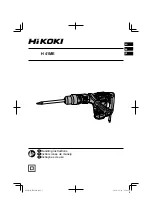
tOOl USE AND cARE
1. Use the right tool for the job.
Do not attempt to force a small tool or attachment to do the work of
a larger industrial tool. The tool will perform better and safer at the task for which it was intended.
Do not modify this tool or use for a purpose for which it was not designed.
2. Maintain tools with care.
Keep tools clean, sharp and in good condition for a better and safer
performance. Follow instructions for lubricating and changing accessories. Inspect tool fittings,
allignment and hoses periodically and, if damaged, have them repaired by an authorized technician
or replaced. The handles must be kept clean, dry and free from oil and grease at all times. A
properly maintained tool reduces the risk of binding and is easier to control.
3. Remove adjusting keys and wrenches.
Check that keys and adjusting wrenches are removed
from the tool or machine before connecting it. A wrench or key that is left attached to a rotating part
of the tool increases the risk of personal injury.
4. Avoid unintentional starts.
Be sure that the throttle switch is in neutral or OFF position when not in
use and before connecting it to any power/air source. Do not carry the tool with fingers near or on
the switch.
5. Only use the lubricants supplied with the tool or specified by the manufacturer.
Other
lubricants may not be suitable and may damage the tool or even make the tool explode.
SERvIcE
1. check for damaged parts.
Before using any tool, any part that appears to be damaged should
be carefully checked to determine that it will operate properly and perform it's intended functions.
Check for alignment and binding of moving parts; broken parts or mounting fixtures, or any other
condition that may affect proper operation. Any part that is damaged should be properly repaired or
replaced by a qualified technician.
2. When servicing, use only identical replacement parts.
Only use accessories intended for use
with this tool.
ElEctRIcAl SAfEty
1. Disconnect power supply.
Disconnect from power supply when not in use, before cleaning,
servicing or changing a piece or accessory.
2. Protect yourself against electric shocks when working on electrical equipment.
Prevent body
contact with grounded surfaces such as pipes, radiators, ranges and refrigerators. There is an
increased chance of electrical shock if your body is grounded.
3. Double Insulated tools are equipped with a polarized plug (one blade is wider than the other),
this plug will fit in a polarized outlet only one way.
If the plug does not fit fully in the outlet,
reverse the plug. If it still does not fit, contact a qualified electrician to install a polarized outlet. Do
not change the plug in any way. Double Insulation eliminates the need for the three wire grounded
power cord and grounded power supply system.
4. Grounded tools must be plugged into an outlet properly installed and grounded in accordance
with all codes and ordinances.
Never remove the grounding prong or modify the plug in any
way. Do not use any adapter plugs. Check with a qualified electrician if you are in doubt as to
whether the outlet is properly grounded. If the tool should electronically malfunction or break down,
grounding provides a low resistance path to carry electricity away from the user.
5. Don’t expose power tools to rain or wet conditions.
Water entering a power tool will increase the
risk of electric shock.
6. Do not abuse the cord.
Never use the cord to carry the tools or pull the plug from an outlet. Keep
cord away from heat, oil, sharp edges or moving parts. Do not operate this tool if the power cord
is frayed or damaged. Replace damaged cords immediately. Damaged cords increase the risk of
electric shock. Do not modify the plug in any way.
7. When operating a power tool outside, use an outdoor extension cord marked “W-A” or “W”.
These cords are rated for outdoor use and reduce the risk of electric shock.
8. Avoid using an unecessarily long extension cord.
Choose a cord that is appropriate for the
situation, as a cord that is too long and running across the floor can be more dangerous than
helpful.
For any technical questions, please call 1-800-665-8685
2


























